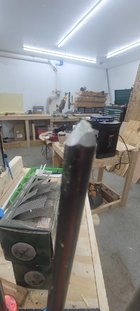Lately most of my bowls have been kiln dried largely because I'm a cabinet maker and have bowl-worthy offcuts of thicker Lumber that I happily chuck up on the lathe. Usually these bowls are side grain, not hollowing end grain. And sometimes they are typical glue ups/segmented.
Soon I'll be upgrading my grinder wheels to CBN so while I'm at it I may grab a new gouge and jig.
My main go-to gouges are a 1/2" Benjamin's Best and P&N 5/8" both using an Ellsworth jig to sharpen. The Benjamin's seems to accept the parabolic Flute using the stock instructions a little better.
They seem to hollow the dried wood ok, but what do y'all prefer on dried wood?
Soon I'll be upgrading my grinder wheels to CBN so while I'm at it I may grab a new gouge and jig.
My main go-to gouges are a 1/2" Benjamin's Best and P&N 5/8" both using an Ellsworth jig to sharpen. The Benjamin's seems to accept the parabolic Flute using the stock instructions a little better.
They seem to hollow the dried wood ok, but what do y'all prefer on dried wood?


